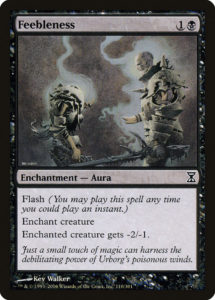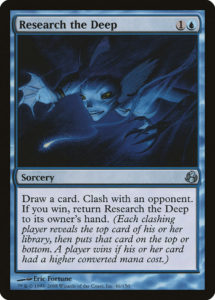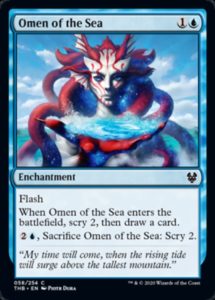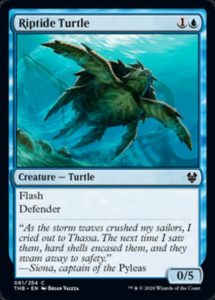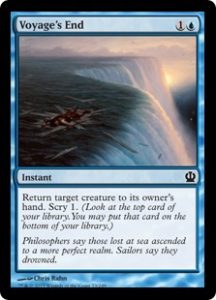Blue is usually the hardest color to evaluate, since its power is subtle. Its creatures tend to be below rate—it pays full retail for flying while other colors get above-rate creatures with Menace or Trample. Yet somehow blue has consistently performed well in Limited for several years. Cards like Callous Dismissal, Divination, and Voyage’s End are outstanding cards whose unique effects overperformed in their environments.
This dominance tends to be hidden when evaluating sets as a whole. It’s only when we get our hands dirty playing a format that we learn just how strong blue can be. So, how strong is blue in Theros Beyond Death?
Initial Impressions
At first blush, blue seemed quite bad. Its normally anemic creatures lack oomph. Sure, Witness of Tomorrows can close out games, but enchantment creatures that cost 4+ mana are more liabilities than boons, as they die to removal spells that every color has ample access to. Vexing Gull seems just as bad as I pegged it—too small to be a relevant threat, easy to answer when it was good, and not a great consolation prize for holding up and not using Deny the Divine.
Blue’s mechanical themes are especially weak, as discussed last week. It has no Escape creatures, denying it the set’s most powerful and easiest-to-use mechanic. It has almost no rewards for Devotion and there are practically no powerful payoffs for Flash-matters in the set. It has the most rewards in Constellation; and even then, you need uncommons or a second color to get any more than a cheaper Brine Giant or a single turn of flying for a Triton Waverider. Blue seemed like a support color you’d happily dip into for card draw or a mega-bomb like Dream Trawler or Nadir Kraken, but not something you’d be excited to have as a primary color.
One Step Deeper
As I drafted on Magic Online and in paper and played at MagicFest New Jersey, I found that it’s not blue that’s anemic at common in Theros Beyond Death, it’s every color (though red really feels a step below the rest). Sure, each color has powerful commons, especially their removal spells. However, it’s this preponderance of top tier common removal (especially in black) that makes answering relevant threats easy. This leads to board stalls, usually where one side is racing to bring back their Escape creature for the third time or someone is getting pecked to death by Sunmane Pegasus. There’s a ton of power locked up in the format’s rares, making it so games are often decided by who lands an unanswered rare haymaker (or resolves a nearly-unstoppable mega-bomb like Dream Trawler or Phoenix of Ash).
The format’s low power level at common is exacerbated by the set’s weak archetypes—all the A+B mechanics like Constellation, Devotion, Heroic, Flash-matters, and Ferocious require you to find two different kinds of pieces to enable a payoff, and those payoffs are fairly mediocre. You’re at the mercy of the top of your deck to find the two pieces you need and the right answers to your opponent’s threats.
To recap: the format has a chunky power level, with many rares leagues above most cards and a bunch of replacement-level commons. Board stalls can happen without too much difficulty. And its synergies aren’t strong but even accessing them requires being able to combine cards with different properties. All of these factors benefit disproportionately from one thing: card smoothing. That brings us to today’s surprise: blue’s best common.
The New Voyage’s End
Once again, a 1U instant is the best blue common in Theros. You might think I’m crazy to not select Ichthyomorphosis or the superior draw spell, Thirst for Meaning. I used to think they were better, too. The thing is, Ichthyomorphosis is fairly replaceable when every other color has better removal (and it can be a liability when your opponent has enchantment removal). Yes, you’ll happily play it, but three is a very crowded slot in blue decks, which is also a knock against Thirst for Meaning. Thirst is a great card, don’t get me wrong—but given how weak blue’s commons are, it can be dangerous to pitch any action at all, making Thirst oftentimes a filtering spell rather than a card advantage spell.
Omen of the Sea is the perfect card for every blue deck. It slots in early on the curve when blue has almost nothing to do with its mana. Like all the Omens, it interacts with almost every theme in the set; but it is the best Omen for finding the cards you need, be they the A to your B, your mega-bomb, or just making sure you draw the right balance of lands and spells. The reason that a deck whose only true win condition is Dream Trawler can work is that Omen of the Sea digs up to five cards deep. It’s an effect I find I can’t get enough of, whereas Thirst for Meaning is expensive enough that it constricts my mana, even when I’ve got Naiad of Hidden Coves in play.
The Good
I definitely undervalued some cards in my early estimation, and none more so than Riptide Turtle. Sure, Murmuring Phantasm was awful in Dragon’s Maze, but it didn’t have the advantage of blocking without killing every Escape creature (that’s not a mythic rare or a Phoenix of Ash). Five is a huge amount of toughness in THB, and Riptide Turtle is effectively a removal spell for every common creature, and tends to demand a removal spell in return. It provides the necessary breathing room for blue decks to take control of the game (or the skies) and is something I’m happy to play multiple copies of.
Next up in Stern Dismissal. I was down on this card until I realized I kept losing games I’d have won if I’d had it. Some of the more powerful cards in the format are auras like Iroas’s Blessing, Commanding Presence, Warbriar Blessing, and Mantle of the Wolf. It’s not too difficult to get a massive tempo or mana advantage with a Stern Dismissal without losing card advantage. It’s just so cheap in a format that has scant cheap interaction at instant speed.
The final card I want to praise is Sweet Oblivion, a card I’ve had the pleasure or playing alongside Thassa’s Oracle multiple times. It’s reminiscent of Stream of Thought from Modern Horizons—properly using it tends to involve a ton of patience. Firing it off early is almost guaranteed to draw your opponents into an Escape card or expose it to graveyard hate, but a late-game mill for 12 is often lethal out of nowhere. This is especially easy when black-green, the de facto best deck by virtue of the two colors’ high power at common, is actively milling itself. The more I’ve played blue, the more I’ve wanted this endgame Fireball. Blue decks without bombs can really struggle to close out the game, but most decks have no defense against a sudden Sweet Oblivion.
And that’s blue in Theros Beyond Death. It’s the best color for finding your bombs or just outdrawing your opponent, making it hit higher than its commons suggest it should. It’s a shame that the blue-red archetype seems so unsupported, but I’ve been pleasantly surprised by how every other blue color combination works. I’ve even enjoyed being a blue-heavy deck with Traveler’s Amulets, waiting to open or get passed a powerful off-color card. Here’s hoping this information proves fruitful next week at Players Tour Phoenix.
And, as always, thanks for reading.
—Zachary Barash is a New York City-based game designer and the commissioner of Team Draft League. He designs for Kingdom Death: Monster, has a Game Design MFA from the NYU Game Center, and does freelance game design. When the stars align, he streams Magic (but the stars align way less often than he’d like).

